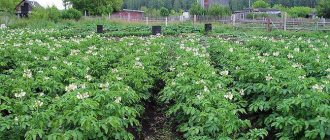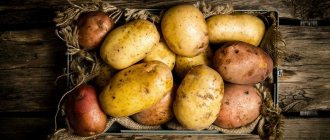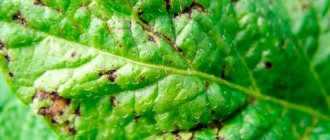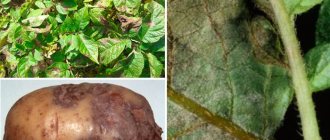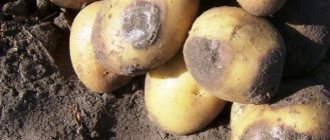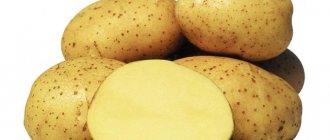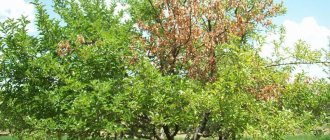Potato cancer
Potato cancer is a quarantine disease that appeared at the beginning of the twentieth century. Where this disease appears, strict quarantine rules must be introduced so that the disease does not spread further. This is explained by the fact that the causative agent of the disease can remain in the soil for 30 years. Potatoes are contaminated with a fungus that causes cancer and should not be eaten. This disease in some cases can destroy the entire potato crop. Therefore, it is very important to know how to deal with potato cancer.
Description of the disease
The development of tuber cancer is explained by the activity of the causative agent of the disease, which in this case is the fungus Synchytrium endobioticum (Schilb.) Perc. It damages not only potatoes, but also other nightshade plants. In this case, the tubers suffer the most, so externally the changes will not be noticeable. Under suitable conditions, pathogenic microorganisms remain viable for up to 30 years. In winter, they take the form of zoosporangia (microscopic cysts with a durable surface), and with the arrival of heat they turn into zoospores.
The optimal temperature values for the development of pathogens will be +15…+18°C, with an increase in humidity up to 80%. More than half of the sporangia appear in June or July, when the process of intensive tuberization is most active. Zoospores emerging from cysts move well through the soil capillaries, but if a suitable plant is not found within 12 hours, penetration into its cells does not occur, and the pest dies.
Important! The causative agent of potato canker cannot tolerate too high or too low temperatures, so if winter temperature drops reach
–
10°C and held for several days, then spores at a depth of 20 cm are likely to die.
This also applies to summer temperature increases up to +30°C. The successful connection of microorganisms with culture cells leads to their active growth and development, which is facilitated by the toxin secreted by the pathogen. Under its influence, neighboring cells quickly grow and divide, actively forming growths with new zoosporangia in their center. The life cycle of the fungus is only 12–14 days, but this is quite enough for massive infection of plantings.
The most common sources of potato cancer infection are:
- shoes or clothes of a summer resident, on which fungus may remain;
- contaminated working tools that were previously used in a contaminated area;
- excrement of farm animals eating raw infected tubers;
- melt water;
- small insects and earthworms that carry spores into the soil to a depth of 50 cm;
- diseased tubers used as planting material.
What is it and possible dangers
Potato cancer is one of the most dangerous diseases known in agronomy. This is due to the fact that the entire crop is quickly infected, first potatoes, then other plant crops - beets, peppers, tomatoes and eggplants. It is caused by a fungal pathogen that settles on the stems or leaves, gradually destroying the plant.
The disease is not dangerous for humans, even after eating potatoes. Despite the fact that in many sources, representatives of health authorities do not recommend consuming non-marketable tubers, there is no exact ban on this. Meanwhile, in developed countries there is a fight against vegetables contaminated with cancer. It is being liquidated and prohibited from being distributed.
Signs of the disease
Dangerous tuber damage can be recognized by the following signs:
- the appearance of growths on the crop that have an unpleasant appearance;
- the formation of wrinkles with small indentations.
The main symptom is growths. At the first stages of fungal infection, they have a light yellow tint, gradually turning brown, then black. The foci of the disease are stems, leaves and the crop itself. Having reached the final stage of the disease, the growths disappear.
A common cause of damage by the pathogen is keeping the crop in unfavorable conditions - with humidity more than 55% and air temperature exceeding 22 degrees. There are also several reasons associated with poor crop care:
- growing tubers in a shaded place;
- missing, insufficient or incorrect soil fertilization;
- use for sowing seeds of low quality, not resistant to cancer.
Infection occurs instantly. The pathogen infects the plant from top to bottom - first the green mass, and lastly the root system and fruit. The disease quickly spreads to neighboring plant crops, gradually filling the entire garden.
Pathways and sources of pathogen
Oncological disease is formed from the influence of a pathogenic fungus, which penetrates a healthy bush from contaminated soil, thawed water, boots or clothes of an agronomist, tools, or from diseased tubers.
Often, potato cancer occurs when it is planted in the same place for several years in a row. Renew the soil from time to time or choose a new place to plant your crops. At the same time, during dry periods it progresses less, since for this it needs increased moisture.
Signs of potato damage
The development of cancer of the root crop in question occurs in several stages, each of which is characterized by certain changes in the appearance of the tubers: first, small whitish tubercles form near the eyes, then they begin to darken and over time transform into warty brown growths. In some cases, the size of such new growths exceeds the size of the tuber itself and resembles cauliflower inflorescences.
Did you know? Linzer Blaue and FranzösischeTrüffelkartoffel are deservedly considered the rarest and most unusual varieties of potatoes: even after heat treatment, they retain their rich purple color, adding unusualness to any dish.
Smaller brown tubercles form on the stolons, and large green ones can be found in the leaf axils or on the inflorescences: the flowers grow together into one lump. The roots of the plant are not affected by the fungus, so you will only be able to find out about the problem in the fall, when most of the crop has rotted in the ground. Surviving tubers may also be damaged, which will become known after several months of storage.
In rare cases (most often in dry times), potato cancer can take other forms:
- leaf-shaped — the growths that appear on the peel are more like fleshy leaves or oyster mushrooms that form on the trunk of trees;
- corrugated - bumpy areas appear on the usually flat surface of the tuber, and the peel gradually wrinkles;
- scabby - a large number of tiny areas of scab appear on the potato skin.
In any of these cases, the marketability and taste of the tubers will be reduced, so they are not used for preparing any dishes.
VEGETABLE GROWING
Quarantine facility. It was first described by Karl Schilberski in 1896 based on analyzes of material from Austria-Hungary collected there in 1888.
In the CIS, the first outbreaks of the disease were registered in 1935 on private plots in the city of Slavuta, Ukraine. The disease became relatively widespread during the Great Patriotic War. Now foci of potato cancer are found throughout almost the entire territory of the European part of the country, in most cases in private plots where varieties susceptible to the disease are constantly grown.
Potato cancer is one of the most dangerous diseases, affecting mainly tubers. It is known when a disease, developing unhindered for several years in conditions of constant potato cultivation, caused complete destruction of the crop.
According to N.A. Dorozhkin (1948), the shortage of potatoes due to cancer reaches 23-64%.
In the conditions of the Transcarpathian region, in foci with aggressive pathotypes, crop shortages amount to 80-90% (Kuzmina L.P., 1972).
According to A. A. Yachevsky and S. P. Zakrividoroga and his colleagues, the use of potato tubers from cancer patients (even boiled) for animal feed leads to severe illness and death.
The causative agent of potato cancer affects all plant organs, with the exception of the roots. The disease manifests itself in the form of growths on tubers, stolons, and root collars; stems, leaves, and flowers are less commonly affected. It has been established that the pathogen affects only young growing plant tissue. On tubers in their earliest phases, the disease can develop over the entire surface; later, cancerous growths appear mainly near the eyes. Before the formation of typical growths, the disease manifests itself in the form of mild swelling and discoloration of the affected areas, which is clearly visible on tubers with colored skins.
Due to the vigorous proliferation of cells located near the point of entry of the parasite, growths are formed, which consist of tissues that have grown abnormally under the irritating influence of the fungus. The surface of the growths is wavy, folded and covered with small yellow-brown dots - sori of zoosporangia (a sorus is a group of zoosporangia formed from one amoeboid). On the affected underground parts of the plant, the size of the growths varies greatly. At first they are small, about the size of a pinhead, and then, growing, they often exceed the size of a tuber, reaching 7-15 cm and resembling a cauliflower inflorescence in appearance. Young growths are white and as they age they become light brown and then dark brown.
Healthy potato tubers planted in contaminated soil are affected at the time of germination in the eye area. If the parasite penetrates simultaneously into several eyes on a tuber, then several growths form on it. Cork tissue does not form on them, therefore, under the influence of soil moisture and the activity of various saprophytic microorganisms, they quickly decompose.
N.A. Dorozhkin described three more forms of manifestation of potato cancer: leaf-shaped, scab-shaped and corrugated. They arise under the influence of unfavorable climatic conditions.
The leaf-shaped form is formed as a result of the growth of ocular scales in the form of fleshy, ugly leaves with sometimes venation. When strongly developed, such growths resemble opening pine cones.
The scab-like form of the lesion appears on tubers in the form of ulcers or crusts of hypertrophied tissue, similar to the manifestation of ordinary scab on tubers.
With the corrugated form, wavy, wrinkled growths with bulges and depressions form on the tubers.
At the Research Institute of Chemical Chemistry, another form of tumor tissue of tubers was identified - “crater-shaped”, which is convex round formations in the form of craters with sharp, uneven edges at the top and a somewhat recessed middle. New growths reach 1-1.5 cm in diameter and can be located in any part of the tuber surface.
On stolons, the fungus infects the tuber formation points. Growths form at the sites of parasite penetration, but the stolons continue to grow and a chain of 4-5 growths appears on them. In these cases, tubers are not set.
When the root collar is damaged, the same growths form as on tubers, which are often noticeable on the soil surface. The growths in the upper part, located above the soil surface, are green in color, and in the lower part, located in the soil, they remain white until they rot. The disease on above-ground plant organs most often manifests itself on the main stems and lateral branches. Green growths 2-2.5 cm in size form in the axils of the leaves. The shoots in this place are usually curved and covered with small growths. On the leaves, the leaf blades thicken and become deformed, and the final lobe of the leaf turns into a continuous growth. The inflorescences hypertrophy into a continuous growth of a bizarre shape. Sometimes only the stamens are affected, becoming completely deformed.
The causative agent of potato canker is Synchytrium endobioticum (Shild.) Pervs. obligate intracellular parasite.
Karl Shilbersky (K. Schilbersky, 1986) attributed it to the species Chrysophlyctis endobioticum.
In 1909, J. Percival, having studied the development of this fungus and the presence of two types of zoosporangia in it - summer and winter - assigned it to the genus Synchytrium.
Currently, the causative agent of potato cancer belongs to the species Synchytrium endobioticum (Shilb.) Perc. order Chytridiales, class Chytridiomycetes. This is the simplest mushroom that does not have a mycelium, and the vegetative body consists of a lump of bare protoplasm. In the development cycle of the pathogen, resting or winter zoosporangia, summer zoosporangia and zoospores are formed. The fungus persists in the soil in the form of winter zoosporangia, which form in growths by autumn. The dormant period of winter zoosporangia ranges from 1.2-2.5 months to several years due to their non-simultaneous formation and different maturity. In the spring, when favorable conditions occur and a host plant is present, 200-300 zoospores are formed in the zoosporangium, which, when the shell ruptures, come out and enter the soil. They are colorless, ovoid or pear-shaped, 2-2.5 microns in size with one whip-shaped, backward-directed flagellum, 10-25 microns long. With its help, zoospores actively move in moist soil up to 10 cm horizontally, 10-15 cm up and up to 15-20 cm down. They remain viable in soil for no more than 2 hours.
Having reached the receptive tissue of the host plant, the zoospores lose their flagellum, dissolve, with the help of the fat contained in them, the cell membrane of the epidermal layer of potato tissue, and into the small pore formed, the protoplast is poured into the cell of the subcortical tissue, where the fungus assimilates the host’s nutrients. Many vacuoles appear in the plasma of the host cell, which subsequently merge. After the disappearance of the protoplast, the fungus covers itself with a two-layer shell and forms a prosorus (vegetative body). It is able to germinate immediately, forming a sac-like outgrowth covered with a thin inner shell. Protoplasm and the nucleus pass into this outgrowth, which immediately divides many times. After this, the sorus is divided into 4-9 multinucleate sections covered with their own thin membranes - summer zoosporangia with numerous (200-300) uniflagellate, mononuclear zoospores.
Simultaneously with the formation of summer zoosporangia, healthy plant cells divide and grow around the infected cell. From the pressure caused by the growing cells, zoosporangia are squeezed out and fall into the soil.
Summer zoosporangia, in contrast to winter ones, are gray, with a single-layer thin shell and well-defined fine granularity. Zoosporangia germinate in the soil. Zoospores, together with soil moisture, move through soil capillaries and infect young tissues of susceptible potato varieties. According to N. S. Yakovleva (1963) and others, zoospores die if they do not infect the host plant within 40 minutes. Each zoospore, once on the potato, penetrates the cell of the susceptible tissue and forms a new focus of the disease.
One cycle of fungal development lasts 10 - 12 days. During the growing season it can produce several generations.
This is how the asexual reproduction cycle of the fungus occurs, which serves to spread the pathogen during the growing season.
Along with the asexual one, the causative agent of potato cancer has a sexual reproduction cycle, during which copulation of two zoospores occurs. During this, the contents of the zoospores are drained. A sexually mobile biflagellate zygote with one diploid nucleus appears, which penetrates the tissues of the potato plant, where it grows, develops, increases in size and turns into a single thick-walled overwintering zoosporangium.
At the same time, the fungus acts on the host cells, which begin to divide in a tangential direction. As a result, the pathogen is immersed deep in the tissue.
Overwintering zoosporangia look like round or oval cells. Their size depends on the conditions of development of the fungus. As revealed by the staff of the Research Institute of Chemical Chemistry, in the conditions of the Russian Federation, the size of winter zoosporangia of the potato cancer pathogen is 21-121x22-100 microns.
The zoosporangium shell with a total thickness of 7.6 microns has three protective layers: a thin and transparent endosporangium, a thicker and golden-yellow mesosporangium, and an outer episporangium. The last two layers consist of cellulose encrusted with lignin and brightly colored lipoids. The episporangium is the cell wall of the host plant. Its composition is similar in properties to chitin.
At high soil moisture, resting zoosporangia mature and germinate in parallel with summer zoosporangia, thereby ensuring the release of a large number of zoospores into the soil during the growing season. The number of germinating zoosporangia is constant over the years and months of the growing season (Tarasova V.P., 1978). Each month of the summer season, on average, up to 30% of wintering zoosporangia germinate in the soil. Deviations are possible with sharp fluctuations in temperature or high humidity: Prolonged drought delays germination, the total number of germinated zoosporangia decreases; rainy summer accelerates the germination of zoosporangia located in the soil and their maturation in the cancer growths of the current year.
According to N.N. Vladimirskaya, some zoosporangia germinate (form zoospores that are released into the soil) already in the year of formation, the bulk - in the second year, and a small number of them are in a state of suspended animation and can remain viable for up to 20-30 years. especially in deeper layers of soil.
The optimal conditions for the germination of zoosporangia are: temperature 14–20ْС, pH of the environment from 7 to 8, soil moisture within 80–90% of the MPV and sufficient oxygen supply. The activity of maturation and germination of zoosporangia increases when they are exposed to root secretions of potatoes, corn, peas, etc.
According to N.A. Dorozhkin, in well-aerated soil under black fallow for several years, all zoosporangia practically germinate or die.
Nitrogen mineral and organic fertilizers (especially ammonium sulfate, urea, cow manure, bird droppings, ammonia water) stimulate the germination of zoosporangia. According to V.P. Tarasova (1978), a high percentage of germination of zoosporangia is also ensured by the introduction of salts containing microelements such as zinc sulfate, ammonium molybdate, copper sulfate, and boric acid.
Potatoes can become infected if 100 g of soil contains at least 700-2000 viable zoosporangia (Popkova K.V., Volovik A.S., 1980).
The causative agent of potato cancer has great parasitic plasticity, which determines its ability to form new, more aggressive pathotypes. Now, according to the international nomenclature adopted by the European and Mediterranean Plant Protection Organization (EPPO) in 1982, more than 20 new pathotypes have been registered.
Currently, foci of new pathotypes have been found in a number of places in Germany and the Czech Republic, etc. There are reports of infection of cancer-resistant potato varieties in Italy (near Milan), India, Canada (Newfoundland Island), (Evremko T. E., 1986).
In the CIS, in the mountainous zone of the Carpathians, several highly aggressive pathotypes of the causative agent of potato cancer were identified, the identification of which was carried out by employees of the All-Union Research Station on Potato Cancer V.I. Yakovleva (11 Mezhgorye (1961); 13 - Rakhov (1962); 16 - Synevyr (1972 ); 18 - Yasinya (1976) and L.P. Saltykova (20 - Sheshory (1979); 21 - Sokolovka (1979); 22 - Bystrets (1980).
To identify pathotypes (an intraspecific taxonomic unit associated with a specific genotype of the host plant), the method of signal planting of differentiator varieties developed by the All-Russian Scientific Research Institute for Potato Cancer (Yakovleva V.I., Saltykova L.P.) is used. The criteria for including varieties in the differential set is their ability to identify only certain pathotypes with a clear response to infection.
The main test assortment recommended for differentiating pathotypes of the causative agent of potato cancer in the CIS consists of varieties divided by genotype into 4 groups: 1 - affected by all known pathotypes; 2 - resistant to pathotype 1 and not affected by all known pathotypes; 3 - resistant to pathotype 1, but with different reactions to other pathotypes; 4 - resistant to pathotype 1 and all other known pathotypes.
The causative agent of potato canker, being an obligate parasite, has a strict specialization and, in addition to potatoes, affects a certain number of plants from five genera of the Solanaceae family (Phadtare, Scharma, 1971).
According to K.E. Sharikov (1975), of the tested 8 varieties of tomatoes and 56 species of wild nightshade, 3 varieties and 25 species were affected, respectively, and growths formed in yellow nightshade and physalis physalis. Thus, along with potatoes, all other host plants - tomato, slime, datura, black, yellow and bittersweet nightshade, black henbane, 8 species of the genus Physalis and some others - can be reservoirs of infection.
The main sources of potato cancer infection are soil and tubers. The causative agent of the disease, entering the soil during the decay of cancerous growths, is in it at the stage of resting zoosporangia and persists, without losing viability, for decades. Therefore, the main source of infection spread is soil.
Along with this, the disease can be spread by root crops, seedlings of fruit and berry crops and seedlings of all kinds of plants that have particles of contaminated soil adhered to the surface of the roots, as well as by soil washed away by streams of melt and rainwater. The possibility of the pathogen spreading through manure taken from farms where raw potatoes infected with cancer were fed to livestock cannot be ruled out, since zoosporangia of the cancer pathogen, having passed through the digestive tract of animals, remain viable.
Plants are most intensively infected at temperatures of 9–19 °C and high soil moisture. Under natural conditions, potato cancer develops well in areas where the average annual air temperature is less than 8 ° C, the average monthly temperature in July is less than 18 ° C, the average annual precipitation is more than 500 mm and most of it occurs in the summer (400-450 mm). Recently, its appearance has been noted in the southern regions of the country, where the pathogen can develop in irrigated areas.
The disease has been noted in different types of soils with different saturation of organic matter.
In order to timely detect foci of cancer, prevent its further spread, quickly localize and eliminate the infection, potato plantings are systematically examined, primarily in seed farms. The frequency of inspection is established by the “Instructions for preventing the spread of potato cancer.” This is done once every 1-4 years, depending on the category of plantings and the presence of disease foci in the area.
The disease manifests itself better at the end of flowering and at the beginning of potato harvesting. At the same time, the tops, stolons and tubers are examined.
In order to localize identified foci of infection, it is prohibited to export potatoes from populated areas where the disease was detected.
In the outbreak of potato cancer, special measures are taken to eliminate it. In this case, the affected tubers, tops and stolons with growths are collected, boiled or treated with a 15% aqueous solution of formaldehyde and buried to a depth of 1 m in the infected area. Healthy potatoes are used only boiled. Then the soil is chemically disinfected from the pathogen.
Considering that in the overwhelming majority of disease foci are detected in the household sector, employees of the All-Russian Scientific Research Institute for Potato Cancer, VNIGINTOX and VNIIKR have developed a method for disinfecting foci in areas with fruit and berry plantings. It includes preparing the site for disinfection, determining the infectious load and viability of zoosporangia using one of the known methods, and disinfecting the soil with a mixture of copper sulfate and urea (in a ratio of 1: 3 by weight at the rate of 100 g/m2, evenly scattered throughout the site). This area, 7-10 days after the application of the preparations, is allowed to be sown with row crops such as corn, beets, and pure cancer-resistant potato varieties, so that during the growing season and the two subsequent years after disinfection, the soil is subjected to intensive loosening. An open biotest of the effectiveness of soil disinfection against the causative agent of potato cancer is carried out using the model plot method developed by the staff of the All-Russian Scientific Research Institute for Potato Cancer in the third (after disinfection) year, accompanied by microscopic analysis of soil samples.
To disinfect foci of potato cancer, liquid ammonia is also used, which, as indicated by I. I. Anosov and others (1983), at a rate of 1000 and 2500 kg/ha ensures the complete destruction of the pathogen.
In order to limit the spread of the quarantine disease throughout the country, all breeding centers are carrying out targeted work to develop pathogen-resistant potato varieties.
| < Previous | Next > |
Methods to combat potato cancer
Potato cancer is an extremely unpleasant disease, so the sooner you detect the problem, the greater the chance of successfully solving it. Among the main measures to combat the disease, the most effective are agrotechnical and chemical methods, which involve the implementation of a number of standardized actions.
Find out how to deal with potato diseases.
Agrotechnical
If you have already encountered nightshade cancer, then you probably know that every year only a part (no more than 30%) of the zoosporangia stored in the ground are activated, and the remaining amount, together with newly appeared spores, will remain in the soil until next year. The essence of agrotechnical measures is to open as many zoosporangia as possible and destroy the emerging spores due to the lack of a suitable host plant.
To achieve an effective result, you should use one of the following methods:
- Compliance with crop rotation with planting corn instead of potatoes, which is especially important for beds where the disease was already discovered last year (excretion from the rhizome of this crop contributes to the rapid release of zoospores). Also a good solution would be to plant legumes or rye, which have long been famous for their cleansing effect on the soil.
- Sufficient amount of fertilizers . Before spring planting potatoes in a selected area (including in the quarantine zone), it is useful to add manure to the soil at the rate of 300 kg of organic matter per 1 sq.m. In greenhouse conditions, granulated urea can be used to disinfect soil in an amount of 1.5 kg per 1 m².
- Timely destruction of weeds , especially if they belong to the Solanaceae family.
- Dosed watering . In waterlogged soil, spores spread faster throughout its entire thickness.
Each of these actions can also be used for preventive purposes, which will be useful not only for preventing the development of cancer, but also for protecting potatoes from other possible diseases of nightshade crops.
Did you know? The record holder for weight among potato tubers was a specimen weighing 3.8 kg, presented in England at the National Gardening Show in 2010.
Chemical
Chemical methods of combating potato cancer are aimed at preventing the emergence of new foci of the disease and involve disinfecting the soil with a Nitrafen solution (2–2.5%) at the rate of 20 liters of the mixture per 1 m² of plantings. Sometimes chloropicrin (96%) is used for the same purposes - 150 cm³ per 1 m².
However, any of these substances can only be used by specialists represented by members of special units for the fight against plant diseases or specialists from regional stations for the protection of agricultural crops.
Disease prevention
It is easier to prevent any illness than to deal with the consequences of its development.
This also applies to potato tuber cancer, so when planting the crop in any case, you should consider the following recommendations:
- If the presence of fungus in the selected area has already been proven earlier, you should refuse to plant potatoes for the next 7–10 years, and to prevent the land from becoming empty, you can plant corn, legumes or cabbage in the garden bed.
- Be sure to follow crop rotation requirements even in those areas where the described problems have never occurred (the regularity of planting potatoes in the same place should not exceed once every 3–4 years).
- When choosing a plot for potatoes, make sure that next to it there are no beds with other Solanaceae that have the same ailments.
- Be sure to remove all weeds, avoiding thickening of potato plantings.
- Do not buy planting material from dubious sellers, especially from quarantine zones.
- If a quarantine zone has been discovered near your site, it is wiser to plant only cancer-resistant varieties (their continuous planting for 4-6 years will help to completely clean the soil, even if it has been infected with a fungus).
- The use of the well-known varieties Sineglazka and Lorch in the quarantine zone will have to be abandoned for a while, since they will not be able to resist tuber cancer and will only contribute to the appearance of more fungal spores.
And of course, we must not forget about proper plant care, including monitoring soil moisture and the composition of fertilizers used.
Rotten
Rots are found everywhere and are also much more common than potato cancer, but gardeners themselves are often to blame for their appearance, because infection usually occurs during storage of tubers. Dry rot, for example, appears only on potatoes that have cuts, scratches or other damage. Wet rot infects tubers if they are stored at too high a temperature and high humidity.
It is difficult, if not impossible, to treat rot, especially since where there is one fungal disease, others usually soon appear, but infection is quite easy to avoid - just before planting, you just need to carefully examine the tubers that have overwintered in the cellar again (the first time you need to inspect them even during harvest) and discard everything that has signs of rot and even just suspicious spots.
Varieties resistant to potato blight
All known potato varieties can be divided into several groups: early-ripening, mid-early and late-ripening. Each of them has several varieties that are characterized by increased resistance to cancer.
Early ripening:
- Fresco - a semi-spreading variety of Dutch selection. It is distinguished by large round-oval tubers with superficial eyes and yellow skin. Its flesh is light yellow in color, which is preserved during heat treatment.
- Pushkinets is a table variety obtained thanks to the efforts of breeders from St. Petersburg.
The potato bush is erect, with a small number of branches. The tubers are quite large, cream-colored and oval-shaped. Their surface is covered with a mesh skin, under which there is white pulp. Important! Whatever variety you choose, always take into account the rules for storing planting material and the recommended time for planting it. Ideally, it is advisable to buy seed potatoes no earlier than a month before the intended planting, especially if there is nowhere to store the tubers. - Zhukovsky - a table variety of Russian selection, characterized by semi-spreading stem-type bushes and pink round-oval tubers. The flesh of this potato is white, quite dense, slightly watery and does not crumble when cooked. Shallow red eyes are clearly visible on the surface of the smooth skin of the tubers.
Mid-early:
- Nevsky - another variety of potato of Russian selection with erect stems and oblong-rounded tubers with smooth white-yellow skin and slightly deepened slightly pink eyes. The delicate white potato pulp retains its color for a long time and has excellent taste.
- Condor is a Dutch table potato variety. It is characterized by large elongated tubers covered with a reddish skin with yellow flesh underneath. During heat treatment, the color of the pulp does not change.
- Santa - a Dutch variety characterized by medium-tall, compact, erect bushes and large tubers. All of them are oval in shape, with a dense and smooth skin that perfectly protects the fruit from mechanical damage. The eyes are almost invisible on the surface, the flesh is pale yellow in color, with a low starch content (due to this feature, the variety is often used for making chips).
Late ripening:
- Cardinal - a variety of Dutch selection that is widely distributed throughout the world, especially in areas with arid climates. The bushes of the plant are erect with a large number of elongated emerald leaves. Potato tubers are elongated, with rounded edges and superficial eyes. The skin is smooth and even, pale pink in color. The pulp is light, more beige in color, and has good taste.
- Zarevo is a Ukrainian universal variety with good taste. Its potato bushes are erect, semi-spreading, the tubers are round, with a blunt top. The color of the mesh skin is pink, but the flesh is white and does not darken when cooked. Potatoes can be used for any culinary purpose.
- Lasunok - a variety of Belarusian selection, distinguished by powerful tall bushes with hard leaves. The tubers are large (100–200 g each), round-oval, with light yellow skin and medium-sized eyes. The potato pulp has a pleasant taste and is equally suitable for making chips and regular mashed potatoes.
Danger of the disease for humans
Potato cancer is not a human disease and does not pose a threat to human health. However, the disease negatively affects the condition of the tubers, making them unsuitable for consumption. If someone wants to eat a damaged vegetable without pronounced taste properties, then the worst thing that threatens the body is diarrhea.
We recommend that you learn how to deal with scab on potatoes.
Potato cancer is one of the most serious diseases that can destroy your crop. That is why it is worth making every effort to prevent this problem in your area, and if the fungus does get into the garden bed, try to detect it in a timely manner by periodically digging up ripening tubers.
